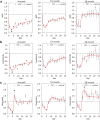Development of a cyclophosphamide stress test to predict resilience to aging in mice
- PMID: 32613492
- PMCID: PMC7732896
- DOI: 10.1007/s11357-020-00222-z
Development of a cyclophosphamide stress test to predict resilience to aging in mice
Abstract
The concept of resilience, defined as the ability to recover from stress, is a potential platform to predict healthy aging. However, specific stress tests for resilience have not yet been fully established in humans so investigations in animal models are of interest. The chemotherapeutic drug cyclophosphamide (Cyp) was selected as a chemical stressor to investigate resilience response in C57Bl/6 male mice at 4, 15, and 28 months of age. Following a single intraperitoneal injection of Cyp (100 mg/kg), tail blood was collected for counting white blood cells (WBC) every other day for 25 days, and physiological performance tests performed. Cyp induced a consistent pattern in neutrophil count in all three age groups, with a nadir at day 5 and a rebound at day 7 with different rates in each group. The neutrophil to lymphocyte ratio (NLR) showed an age-dependent rebound response 7 days after Cyp injection, with a similar pattern of decline back toward baseline. Mice in the 15-month age group with high pre-injection Cyp NLR had significantly higher total WBC counts after Cyp injection compared with mice with low pre-injection Cyp NLR, indicating a correlation between NLR and Cyp-altered WBC counts. In addition, mice with high pre-injection Cyp NLR showed significant learning impairment compared with mice with low pre-injection Cyp NLR, suggesting low NRL intensity can predict resilience to age-related cognitive decline. These observations provide the rationale to translate findings from the mouse to humans in developing in vitro Cyp stress tests.
Keywords: Aging mice; Cyclophosphamide; Neutrophil lymphocyte ratio; Resilience to aging; Stress test; WBC count.
Conflict of interest statement
The authors declare that they have no conflicts of interest.
Figures





References
-
- Allen RS, Dorman HR, Henkin H, Carden KD, Potts D. Definition of resilience. In: Resnick B, Gwyther LP, Roberto KA, editors. Resilience in aging: concepts, research, and outcomes. Cham: Springer International Publishing; 2018. pp. 1–15.
-
- Baguley BC, Beland FA, Berger MR, et al. A review of human carcinogens. Iarc, France: Pharmaceuticals; 2008.
Publication types
MeSH terms
Substances
Grants and funding
LinkOut - more resources
Full Text Sources

